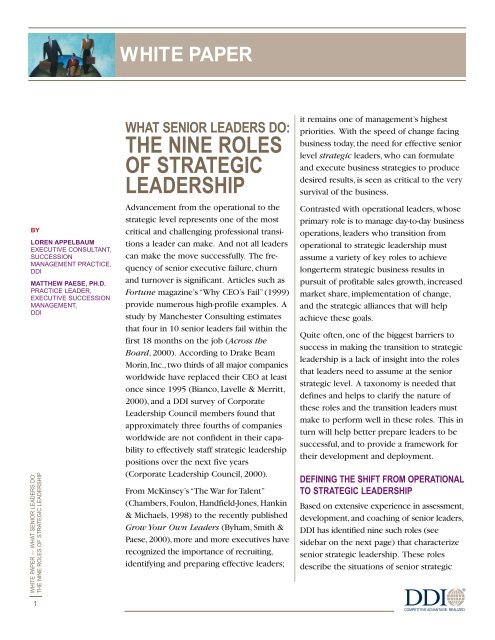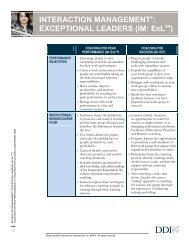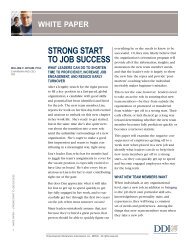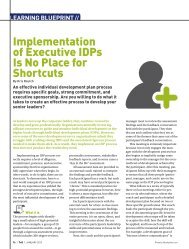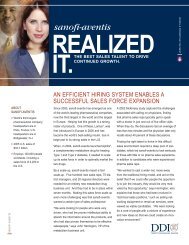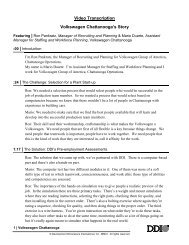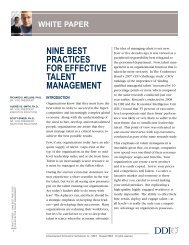What Senior Leaders Do: The Nine Roles of Strategic Leadership
What Senior Leaders Do: The Nine Roles of Strategic Leadership
What Senior Leaders Do: The Nine Roles of Strategic Leadership
You also want an ePaper? Increase the reach of your titles
YUMPU automatically turns print PDFs into web optimized ePapers that Google loves.
BY<br />
LOREN APPELBAUM<br />
EXECUTIVE CONSULTANT,<br />
SUCCESSION<br />
MANAGEMENT PRACTICE,<br />
DDI<br />
MATTHEW PAESE, PH.D.<br />
PRACTICE LEADER,<br />
EXECUTIVE SUCCESSION<br />
MANAGEMENT,<br />
DDI<br />
WHITE PAPER — WHAT SENIOR LEADERS DO:<br />
THE NINE ROLES OF STRATEGIC LEADERSHIP<br />
1<br />
WHITE PAPER<br />
WHAT SENIOR LEADERS DO:<br />
THE NINE ROLES<br />
OF STRATEGIC<br />
LEADERSHIP<br />
Advancement from the operational to the<br />
strategic level represents one <strong>of</strong> the most<br />
critical and challenging pr<strong>of</strong>essional transitions<br />
a leader can make. And not all leaders<br />
can make the move successfully. <strong>The</strong> frequency<br />
<strong>of</strong> senior executive failure, churn<br />
and turnover is significant. Articles such as<br />
Fortune magazine’s “Why CEO’s Fail” (1999)<br />
provide numerous high-pr<strong>of</strong>ile examples. A<br />
study by Manchester Consulting estimates<br />
that four in 10 senior leaders fail within the<br />
first 18 months on the job (Across the<br />
Board, 2000). According to Drake Beam<br />
Morin, Inc., two thirds <strong>of</strong> all major companies<br />
worldwide have replaced their CEO at least<br />
once since 1995 (Bianco, Lavelle & Merritt,<br />
2000), and a DDI survey <strong>of</strong> Corporate<br />
<strong>Leaders</strong>hip Council members found that<br />
approximately three fourths <strong>of</strong> companies<br />
worldwide are not confident in their capability<br />
to effectively staff strategic leadership<br />
positions over the next five years<br />
(Corporate <strong>Leaders</strong>hip Council, 2000).<br />
From McKinsey’s “<strong>The</strong> War for Talent”<br />
(Chambers, Foulon, Handfield-Jones, Hankin<br />
& Michaels, 1998) to the recently published<br />
Grow Your Own <strong>Leaders</strong> (Byham, Smith &<br />
Paese, 2000), more and more executives have<br />
recognized the importance <strong>of</strong> recruiting,<br />
identifying and preparing effective leaders;<br />
it remains one <strong>of</strong> management’s highest<br />
priorities. With the speed <strong>of</strong> change facing<br />
business today, the need for effective senior<br />
level strategic leaders, who can formulate<br />
and execute business strategies to produce<br />
desired results, is seen as critical to the very<br />
survival <strong>of</strong> the business.<br />
Contrasted with operational leaders, whose<br />
primary role is to manage day-to-day business<br />
operations, leaders who transition from<br />
operational to strategic leadership must<br />
assume a variety <strong>of</strong> key roles to achieve<br />
longerterm strategic business results in<br />
pursuit <strong>of</strong> pr<strong>of</strong>itable sales growth, increased<br />
market share, implementation <strong>of</strong> change,<br />
and the strategic alliances that will help<br />
achieve these goals.<br />
Quite <strong>of</strong>ten, one <strong>of</strong> the biggest barriers to<br />
success in making the transition to strategic<br />
leadership is a lack <strong>of</strong> insight into the roles<br />
that leaders need to assume at the senior<br />
strategic level. A taxonomy is needed that<br />
defines and helps to clarify the nature <strong>of</strong><br />
these roles and the transition leaders must<br />
make to perform well in these roles. This in<br />
turn will help better prepare leaders to be<br />
successful, and to provide a framework for<br />
their development and deployment.<br />
DEFINING THE SHIFT FROM OPERATIONAL<br />
TO STRATEGIC LEADERSHIP<br />
Based on extensive experience in assessment,<br />
development, and coaching <strong>of</strong> senior leaders,<br />
DDI has identified nine such roles (see<br />
sidebar on the next page) that characterize<br />
senior strategic leadership. <strong>The</strong>se roles<br />
describe the situations <strong>of</strong> senior strategic
WHITE PAPER — WHAT SENIOR LEADERS DO:<br />
THE NINE ROLES OF STRATEGIC LEADERSHIP<br />
2<br />
leadership, and reflect the most vital and<br />
important functions <strong>of</strong> today’s successful<br />
leaders. While strategic leaders are not typically<br />
engaged in all nine roles “all the time,”<br />
they will <strong>of</strong>ten be involved in situations<br />
related to more than one role at any given<br />
time. <strong>The</strong> relative importance placed on<br />
each role is dependent upon the business<br />
situation in which the leader is engaged.<br />
Thus, in one situation a strategic leader may<br />
initially be focused on developing a longrange<br />
course <strong>of</strong> action or set <strong>of</strong> goals to<br />
STRATEGIC LEADERSHIP EXPERIENCE<br />
Just because leaders have been highly successful<br />
in operational/functional roles doesn’t ensure their<br />
success as senior strategic leaders. Yet organizations<br />
routinely rely on these very people to move<br />
into these critical roles. <strong>The</strong> result—senior strategic<br />
leaders who are unprepared to effectively deal with<br />
the situations and challenges they must face.<br />
Through the powerful content and hands-on leadership<br />
simulation <strong>of</strong> <strong>Strategic</strong> <strong>Leaders</strong>hip Experience,<br />
participants will learn how to think and act more<br />
strategically—to strategize ways to grow the<br />
business, gain acceptance <strong>of</strong> their strategies, and<br />
execute them to achieve desired business results.<br />
Session Objectives<br />
Helps leaders:<br />
> Improve their ability to deliver better business<br />
results by applying the nine leadership roles<br />
in the workplace.<br />
> Bridge the gap from operational to strategic<br />
leadership.<br />
> Minimize derailers that can impede their<br />
success as a senior leader.<br />
> Establish peer networks across organizations<br />
and functions.<br />
align with the organization’s vision (the<br />
“Strategist” role). <strong>The</strong> focus might then<br />
subsequently shift to building passion and<br />
commitment toward those goals among the<br />
people who need to take ownership <strong>of</strong> the<br />
strategy or vision (the “Captivator”role). <strong>The</strong><br />
nine roles have general applicability across<br />
all senior leadership positions, and are not<br />
unique to any particular job; however, the<br />
particular focus on any given role at a point<br />
in time will be determined by the business<br />
issues being addressed at that time. Ideally,<br />
an executive team would collectively represent<br />
capabilities across the full spectrum <strong>of</strong><br />
these roles.<br />
Following are the nine key strategic<br />
leadership roles and brief definitions <strong>of</strong><br />
each. A more complete description,<br />
including illustrations for each, is included<br />
in the appendix.<br />
NAVIGATOR—Clearly and quickly works<br />
through the complexity <strong>of</strong> key issues,<br />
problems and opportunities to affect<br />
actions (e.g., leverage opportunities and<br />
resolve issues).<br />
STRATEGIST—Develops a long-range<br />
course <strong>of</strong> action or set <strong>of</strong> goals to align<br />
with the organization’s vision.<br />
ENTREPRENEUR—Identifies and exploits<br />
opportunities for new products, services,<br />
and markets.<br />
MOBILIZER—Proactively builds and<br />
aligns stakeholders, capabilities, and<br />
resources for getting things done quickly<br />
and achieving complex objectives.<br />
TALENT ADVOCATE—Attracts, develops,<br />
and retains talent to ensure that people<br />
with the right skills and motivations to<br />
meet business needs are in the right place<br />
at the right time.
WHITE PAPER — WHAT SENIOR LEADERS DO:<br />
THE NINE ROLES OF STRATEGIC LEADERSHIP<br />
3<br />
CAPTIVATOR—Builds passion and<br />
commitment toward a common goal.<br />
GLOBAL THINKER—Integrates<br />
information from all sources to develop<br />
a well-informed, diverse perspective that<br />
can be used to optimize organizational<br />
performance.<br />
CHANGE DRIVER—Creates an environment<br />
that embraces change; makes change<br />
happen—even if the change is radical—<br />
and helps others to accept new ideas.<br />
ENTERPRISE GUARDIAN—Ensures<br />
shareholder value through courageous<br />
decision-making that supports<br />
enterprise—or unit-wide interests.<br />
<strong>The</strong>se nine roles are important at senior<br />
strategic levels because they help leaders<br />
understand what to do to be strategic. <strong>The</strong>y<br />
address the broader challenges leaders face<br />
as they transition from managing more<br />
narrowly focused “silos,” to taking on the<br />
challenges <strong>of</strong> more enterprise-wide leadership.<br />
<strong>The</strong>se challenges include factors such<br />
as their increased span <strong>of</strong> influence, loss<br />
<strong>of</strong> tactical control, broader consequences<br />
<strong>of</strong> failure, the business scope they are<br />
addressing, their own visibility, and a greater<br />
variety in stakeholders they need to satisfy.<br />
Several factors will determine a leader’s<br />
success or failure in meeting these<br />
challenges, such as his or her underlying<br />
skills or leadership competencies, knowledge,<br />
experience, and executive derailers.<br />
ORIGINS OF THE NINE ROLES<br />
<strong>The</strong> nine roles <strong>of</strong> strategic leadership are<br />
based on more than 30 years <strong>of</strong> research<br />
and practice in the field <strong>of</strong> executive assessment.<br />
<strong>The</strong>y were formulated as a result <strong>of</strong><br />
extensive input from our clients, as well as<br />
job analyses done by DDI’s psychologists.<br />
<strong>The</strong>se analyses included reflecting upon<br />
thousands <strong>of</strong> executive positions across<br />
hundreds <strong>of</strong> organizations throughout the<br />
world that DDI has been involved with over<br />
the years in regard to executive assessment,<br />
and executive coaching and development.<br />
Common themes or patterns underlying<br />
the leadership challenges emerged. Those<br />
themes or patterns formed the foundation<br />
for the strategic leadership roles.<br />
In addition to the above research, DDI<br />
checked the relevance and credibility <strong>of</strong> the<br />
nine roles with more than 100 senior-level<br />
leaders from more than two dozen organizations<br />
that participated in field tests <strong>of</strong> an<br />
executive level accelerated development<br />
program, <strong>Strategic</strong> <strong>Leaders</strong>hip Experience<br />
(SLE). This program provides an in-depth<br />
immersion in a business simulation and an<br />
opportunity to experience the nine roles<br />
(see sidebar description <strong>of</strong> SLE on page 2).<br />
In follow-up debriefings with SLE participants,<br />
these executives strongly reinforced<br />
the relevance and application <strong>of</strong> the nine<br />
roles to their “real world” leadership and<br />
business challenges.<br />
<strong>The</strong>re are numerous models found in<br />
the literature that describe various roles<br />
senior leaders perform. Each <strong>of</strong> these<br />
capture important and relevant roles<br />
appropriate to senior leadership, although<br />
none appear to represent the full range <strong>of</strong><br />
roles we have defined through our analyses.<br />
<strong>The</strong>y do, however, add further support to<br />
the relevance and “construct validity” <strong>of</strong><br />
DDI’s nine roles.<br />
Table 1 highlights elements from four <strong>of</strong><br />
these models, and the corresponding DDI<br />
leadership roles:
WHITE PAPER — WHAT SENIOR LEADERS DO:<br />
THE NINE ROLES OF STRATEGIC LEADERSHIP<br />
4<br />
TABLE 1: Range <strong>of</strong> the DDI <strong>Roles</strong> Compared to Similar <strong>Roles</strong> Defined in Other <strong>Leaders</strong>hip Models.<br />
DDI ROLES Covey 1 Belbin 2 Gallup 3 Mintzberg 4<br />
NAVIGATOR _______ _______ Formulation Disseminator<br />
Monitor<br />
STRATEGIST Pathfinding _______ <strong>Strategic</strong> Thinking _______<br />
ENTREPRENEUR _______ Plant Creativity Entrepreneur<br />
MOBILIZER Aligning Company Worker,<br />
Completer-Finisher<br />
Activator Liaison<br />
TALENT<br />
ADVOCATE<br />
Empowering Resource Investigator _______ Leader<br />
CAPTIVATOR Empowering, _______ Stimulator, Spokesperson<br />
Modeling Persuasion<br />
GLOBAL THINKER _______ Chairman _______ _______<br />
CHANGE DRIVER _______ Shaper _______ _______<br />
ENTERPRISE _______ Monitor-Evaluator _______ Disturbance<br />
GUARDIAN Handler<br />
1 Hesselbein, F., Goldsmith, M., & Beckhard, R. (Eds.). (1996). <strong>The</strong> leader <strong>of</strong> the future: New visions, strategies, and practices for the next era.<br />
San Francisco: Jossey-Bass.<br />
2 Belbin. R. M. (1981). Management teams: Why they succeed or fail. New York: Wiley.<br />
3 Buckingham, M., & C<strong>of</strong>fman, C. (1999). First break all the rules: <strong>What</strong> the world's greatest managers do differently. New York: Simon & Schuster.<br />
4 Mintzberg, H. (1973). <strong>The</strong> nature <strong>of</strong> managerial work. New York: Harper & Row.<br />
In addition, DDI’s nine roles are aligned<br />
with the writings on leadership <strong>of</strong> many<br />
thought leaders who discuss the roles or<br />
capabilities leaders must assume in today’s<br />
business environment. For example, in<br />
summarizing results <strong>of</strong> their 1999 research<br />
on “<strong>The</strong> Evolving Role <strong>of</strong> Executive<br />
<strong>Leaders</strong>hip,” the Andersen Consulting<br />
Institute for <strong>Strategic</strong> Change identified<br />
a number <strong>of</strong> characteristics outstanding<br />
leaders need to possess. Among these<br />
characteristics were the “ability to develop<br />
an effective strategy for achieving the<br />
vision” (DDI’s Strategist role), and “the ability<br />
to inspire people to commit to achieving<br />
the vision” (Captivator role); “creating a<br />
network <strong>of</strong> relationships that helps to get<br />
things done”(Mobilizer); “encouraging<br />
people to challenge the status quo,” and<br />
“be willing to challenge the system when<br />
change is needed” (Change Driver); and<br />
“actively expand his/her knowledge <strong>of</strong><br />
other cultures (through interactions, travel,<br />
etc.)” as well as the need to “appreciate the<br />
value <strong>of</strong> diversity” and “effectively motivate<br />
people <strong>of</strong> different cultural backgrounds”<br />
(Global Thinker).<br />
In New <strong>Roles</strong> for <strong>Leaders</strong>,Tom Hornsby<br />
and Larry Warkoczeski (2000) describe<br />
several roles <strong>of</strong> leadership, among them:<br />
Create a New Mindset (Change Driver);<br />
Leader as Coach, and Develop Employees<br />
(Talent Advocate); Communicate Effectively<br />
(Captivator); Manage Boundaries (Navigator;<br />
Global Thinker); and Making the Transition<br />
(Change Driver). Russell Reynolds<br />
Consulting (Haapaniemi, 2000) describes<br />
six qualities <strong>of</strong> leadership, including:<br />
Recognize Opportunities (Entrepreneur);<br />
Radiate Vision (Captivator); 80/20 Mindset<br />
(Mobilizer); Get the ‘Right Stuff’ (Navigator);<br />
Organizational Improvisers, to get the right
WHITE PAPER — WHAT SENIOR LEADERS DO:<br />
THE NINE ROLES OF STRATEGIC LEADERSHIP<br />
5<br />
people in the right place (Talent Advocate);<br />
and Learning Obsessed. Stuart Skorman,<br />
CEO <strong>of</strong> Hungry Minds, an online learning<br />
company, includes personal attributes such<br />
as contending with constant change, drive<br />
innovation, and inspire and motivate<br />
(Change Driver, Captivator) as key qualities<br />
<strong>of</strong> leaders in the new economy. In describing<br />
Competencies for the New Century, Conger<br />
& Benjamin (1999) describe the need for<br />
future leaders to be <strong>Strategic</strong> opportunists<br />
(Strategist), Globally Adept (Global Thinker),<br />
Keen Data Analysts (Navigator), and Learning<br />
Evangelists (Captivator). And finally, in a<br />
1990 Industry Week article,Tom Peters<br />
describes how chief executives in the coming<br />
decades will need to be, among other<br />
things, globalists (Global Thinker), network<br />
managers (Navigator), skill-base creators<br />
(Talent Advocate), and seekers and lovers<br />
<strong>of</strong> change (Change Driver).<br />
RELATIONSHIP OF ROLES TO<br />
LEADERSHIP COMPETENCIES<br />
Much <strong>of</strong> the writing about leadership<br />
describes the skills or behavior <strong>of</strong> leaders<br />
(competencies) rather than what they do<br />
(roles). We believe both approaches are<br />
necessary to fully develop leadership talent<br />
and that they are interrelated. As noted<br />
earlier, DDI’s nine roles are grounded in<br />
extensive experience and research in<br />
competency-based leadership assessment;<br />
however, the nine leadership roles should<br />
not be thought <strong>of</strong> as a replacement for<br />
competencies. While the roles describe<br />
the “whats” <strong>of</strong> leadership, the competencies<br />
describe the “hows.” Competencies can<br />
be thought <strong>of</strong> as the underlying skills or<br />
behavioral building blocks inherent in the<br />
situational-based roles. Thus, while roles<br />
describe the various contexts in which<br />
clusters <strong>of</strong> competencies are applied at<br />
senior leadership levels, competencies<br />
describe behaviorally specific skills and<br />
abilities that impact effectiveness in those<br />
leadership contexts.<br />
Both competencies and roles are important<br />
to effectively capture aspects <strong>of</strong> leadership<br />
behavior. From a diagnostic perspective,<br />
assessment <strong>of</strong> core competencies provides<br />
an excellent framework for evaluating<br />
specific strengths and development needs<br />
related to executive advancement or placement<br />
decisions. By using the nine roles<br />
as a template for reviewing the challenges<br />
or experiences the executive has faced,<br />
or is likely to face in upcoming assignments,<br />
additional insights can be gained that are<br />
useful in interpreting the application <strong>of</strong><br />
competency evaluations, and helpful in<br />
shaping development. Typically, however,<br />
once executives are determined to have<br />
advancement potential by virtue <strong>of</strong><br />
strengths on key competencies, they<br />
<strong>of</strong>ten are released into their new positions<br />
without ever being provided with a full<br />
appreciation <strong>of</strong> the various roles they will<br />
need to assume in applying their leadership<br />
skills. By looking both at competencies and<br />
the roles, the highest priority development<br />
needs can be determined to fit current or<br />
planned job challenges vis-a-vis the roles.<br />
To illustrate this point, imagine trying to<br />
train an athlete for the decathlon without<br />
ever describing the ten events. <strong>The</strong> training<br />
would <strong>of</strong> necessity be focused on the skills<br />
necessary for success, i.e., the “competencies”<br />
<strong>of</strong> speed, strength, agility, coordination,<br />
etc. But without an appreciation for how<br />
these skills need to come together and be<br />
applied in the various events or “situations”<br />
the athlete will encounter, overall performance<br />
will likely be sub-optimized. Similarly,<br />
many executives report that, after being in
WHITE PAPER — WHAT SENIOR LEADERS DO:<br />
THE NINE ROLES OF STRATEGIC LEADERSHIP<br />
6<br />
their positions for several months, there<br />
were many aspects <strong>of</strong> their jobs that they<br />
never expected and were not adequately<br />
prepared to handle. <strong>The</strong>y didn’t have a<br />
good understanding <strong>of</strong> the “events” or roles<br />
associated with applying their skills to the<br />
situations they encountered. Clearly, the<br />
combination <strong>of</strong> competency-based diagnostic<br />
assessment and development based on<br />
groupings <strong>of</strong> those competencies linked to<br />
the nine strategic leadership roles, provides<br />
the most robust opportunity for building<br />
leadership bench strength.<br />
SUMMARY<br />
<strong>The</strong> leadership crisis is one <strong>of</strong> the most<br />
important issues facing businesses today.<br />
<strong>The</strong> effective identification, development<br />
and deployment <strong>of</strong> senior strategic leaders<br />
are central to addressing this crisis. In addition<br />
to focusing on the skills or competencies<br />
important to leadership success, it also is<br />
important to understand the situations that<br />
must be addressed or the roles strategic<br />
leaders must assume. DDI’s nine roles <strong>of</strong><br />
strategic leadership provide a useful framework<br />
for understanding those situations.<br />
Furthermore, the linkage <strong>of</strong> competencies to<br />
the nine roles provides very powerful and<br />
unique insights that are helpful to addressing<br />
this leadership crisis.<br />
DDI’s roles framework is a viable way to<br />
think about senior leadership activities. <strong>The</strong><br />
application <strong>of</strong> these nine roles to leadership<br />
selection, development, and deployment<br />
decisions can have a significant impact on<br />
the success <strong>of</strong> those leaders and, ultimately,<br />
their businesses, as well.<br />
APPENDIX<br />
<strong>The</strong> <strong>Nine</strong> <strong>Roles</strong> <strong>of</strong> <strong>Senior</strong><br />
<strong>Strategic</strong> <strong>Leaders</strong>hip<br />
NAVIGATOR—Clearly and quickly works<br />
through the complexity <strong>of</strong> key issues,<br />
problems and opportunities to affect<br />
actions (e.g., leverage opportunities and<br />
resolve issues).<br />
Navigators analyze large amounts <strong>of</strong><br />
sometimes conflicting information. <strong>The</strong>y<br />
understand why things happen and identify<br />
possible courses <strong>of</strong> action to affect events.<br />
<strong>The</strong>y know which factors really matter in<br />
the overall scheme <strong>of</strong> things.<br />
Illustrations<br />
> Identifies root causes quickly.<br />
> Displays a keen sense <strong>of</strong> priority,<br />
relevance, and significance.<br />
> Integrates information from a variety <strong>of</strong><br />
sources and detects trends, associations,<br />
and cause-effect relationships.<br />
> Creates relevant options for addressing<br />
problems and opportunities and achieving<br />
desired outcomes.<br />
> Translates complex situations into simple,<br />
meaningful explanations that others<br />
can grasp.<br />
> Provides others with relevant context<br />
for work.<br />
> Overcomes personal and organizational<br />
biases in looking at data; avoids “not the<br />
way we do it here” thinking.
WHITE PAPER — WHAT SENIOR LEADERS DO:<br />
THE NINE ROLES OF STRATEGIC LEADERSHIP<br />
7<br />
STRATEGIST—Develops a long-range<br />
course <strong>of</strong> action or set <strong>of</strong> goals to align<br />
with the organization’s vision.<br />
Strategists focus on creating a plan for the<br />
future. Part <strong>of</strong> this plan might involve capitalizing<br />
on current opportunities and future<br />
trends (Entrepreneur) and understanding<br />
complex information related to future events<br />
(Navigator). Strategists make decisions that<br />
drive the organization toward its vision.<br />
Illustrations<br />
> Continuously looks beyond the<br />
current year.<br />
> Perceives what drives the business.<br />
> Uses financial data for a successful<br />
business.<br />
> Grasps big-picture, enterprise-wide issues<br />
across boundaries.<br />
> Recognizes risks and pursues actions<br />
that have acceptable levels <strong>of</strong> risk.<br />
> Links the organization’s vision and values<br />
to the business strategy.<br />
ENTREPRENEUR—Identifies and exploits<br />
opportunities for new products, services,<br />
and markets.<br />
Entrepreneurs are always alert for creative,<br />
novel ideas. <strong>The</strong>y might generate the ideas<br />
themselves or take existing opportunities or<br />
proposals down a new path. Entrepreneurs<br />
are able to look at events from a unique<br />
perspective and develop ideas that have<br />
never been thought <strong>of</strong>.<br />
Illustrations<br />
> Takes calculated risks to capitalize<br />
on emerging trends.<br />
> Looks beyond the boundaries <strong>of</strong> the<br />
organization for new growth opportunities<br />
(partnerships, new technologies,<br />
applications).<br />
> Turns threats (from competitors, government<br />
policies, and new technologies)<br />
into business opportunities.<br />
MOBILIZER—Proactively builds and<br />
aligns stakeholders, capabilities, and<br />
resources for getting things done quickly<br />
and achieving complex objectives.<br />
Mobilizers gain the support and resources<br />
they need to accomplish goals.<br />
Illustrations<br />
> Leverages and integrates the capabilities<br />
<strong>of</strong> resources across all levels <strong>of</strong> the<br />
organization to accomplish complex,<br />
multiple-level objectives.<br />
> Anticipates and diffuses roadblocks to<br />
desired goals.<br />
> Uses necessary and appropriate lobbying<br />
techniques to gain support for<br />
actions from decision-makers.<br />
> Utilizes creative networking approaches<br />
to identify contacts who can help in<br />
attaining goals.<br />
> Develops alternative/contingency plans.<br />
> Empowers others relative to achieving<br />
the strategy.<br />
TALENT ADVOCATE—Attracts, develops,<br />
and retains talent to ensure that people<br />
with the right skills and motivations to<br />
meet business needs are in the right place<br />
at the right time.<br />
Talent Advocates ensure that the organization<br />
has people with potential to meet<br />
present and future organizational needs.<br />
Talent Advocates are less concerned with<br />
filling specific positions than with attracting<br />
and retaining talented individuals.
WHITE PAPER — WHAT SENIOR LEADERS DO:<br />
THE NINE ROLES OF STRATEGIC LEADERSHIP<br />
8<br />
Illustrations<br />
> Relentlessly identifies and secures<br />
high-potential talent.<br />
> Identifies the best people (internal and<br />
external), gets to know them, and stays<br />
in touch with them.<br />
> Links development assignments to<br />
current and future needs <strong>of</strong> the<br />
organization (as determined by the<br />
business strategies).<br />
> Increases readiness <strong>of</strong> high-potential<br />
talent by providing developmental<br />
opportunities.<br />
> Minimizes barriers to achievement;<br />
maximizes the individual’s likelihood<br />
for success.<br />
> Builds and facilitates a culture that<br />
embraces development.<br />
> Promotes employee retention by analyzing<br />
and understanding its drivers.<br />
CAPTIVATOR—Builds passion and commitment<br />
toward a common goal.<br />
Captivators build upon an established foundation<br />
<strong>of</strong> trust to instill people with feelings<br />
<strong>of</strong> excitement and belonging. Captivators<br />
transfer the energy <strong>of</strong> their message in such<br />
a compelling way that people take ownership<br />
<strong>of</strong> the strategy or vision and are empowered<br />
to carry it out.<br />
Illustrations<br />
> Conveys a simple, vivid picture <strong>of</strong> the<br />
organization’s vision and goals.<br />
> Moves people from compliance to<br />
commitment.<br />
> Instills others with a strong sense <strong>of</strong><br />
belonging (they understand how they<br />
will benefit).<br />
> Generates energy and enthusiasm<br />
through personal passion and conviction.<br />
> Keeps the message alive and ongoing.<br />
GLOBAL THINKER—Integrates information<br />
from all sources to develop a wellinformed,<br />
diverse perspective that can<br />
be used to optimize organizational<br />
performance.<br />
Global Thinkers understand and accept<br />
international and cultural differences and<br />
behave in a way that accommodates<br />
people’s varying perspectives. <strong>The</strong>y also<br />
discern differences in individual styles<br />
and adapt their approaches accordingly.<br />
Illustrations<br />
> Considers the implications <strong>of</strong> issues,<br />
decisions, and opportunities beyond<br />
the boundaries <strong>of</strong> own country/culture.<br />
> Understands the different perspectives<br />
and approaches in order to effectively<br />
handle cross-cultural challenges/individual<br />
differences.<br />
> Identifies opportunities for global<br />
leverage (for example, opportunities to<br />
develop R&D strategy from a global<br />
point <strong>of</strong> view).<br />
CHANGE DRIVER—Creates an environment<br />
that embraces change; makes change<br />
happen—even if the change is radical—<br />
and helps others to accept new ideas.<br />
Change Drivers focus on continuous<br />
improvement. Always challenging the status<br />
quo and breaking paradigms, they identify<br />
ideas for change and become the force<br />
driving the change home.
CONTACT INFORMATION<br />
WORLD HEADQUARTERS<br />
PITTSBURGH<br />
412.257.0600<br />
EMAIL: INFO@DDIWORLD.COM<br />
WWW.DDIWORLD.COM/LOCATIONS<br />
WHITE PAPER — WHAT SENIOR LEADERS DO:<br />
THE NINE ROLES OF STRATEGIC LEADERSHIP<br />
9<br />
Illustrations<br />
> Sees the possibility for change.<br />
> Recognizes the need for change before it<br />
becomes critical.<br />
> Sells ideas for change.<br />
> Funds and supports the implementation<br />
<strong>of</strong> change and rewards behavior that<br />
supports change.<br />
ENTERPRISE GUARDIAN—Ensures<br />
shareholder value through courageous<br />
decision-making that supports enterpriseor<br />
unit-wide interests.<br />
Enterprise Guardians rise above the parochial<br />
nature <strong>of</strong> the job and make decisions that<br />
are good for the shareholder, even if the<br />
decisions cause pain to individuals or to the<br />
organization.<br />
Illustrations<br />
> Refuses to trade long-term for<br />
short-term gain.<br />
> Possesses the courage to make difficult<br />
decisions in times <strong>of</strong> success.<br />
> Objectively upholds the interest <strong>of</strong> the<br />
enterprise by putting aside emotions<br />
and personal relationships.<br />
> Takes responsibility for unpopular<br />
decisions and their aftermath.<br />
REFERENCES<br />
Andersen Consulting Institute for <strong>Strategic</strong> Change. (1999).<br />
<strong>The</strong> evolving role <strong>of</strong> executive leadership.<br />
Chicago: Andersen Consulting.<br />
Belbin. R. M. (1981).<br />
Management teams: Why they succeed or fail.<br />
New York: Wiley.<br />
Bianco, A., Lavelle, L., & Merritt, J. (2000, December 11).<br />
<strong>The</strong> CEO trap.<br />
Business Week, 3711, 86-96.<br />
Buckingham, M., & C<strong>of</strong>fman, C. (1999).<br />
First break all the rules: <strong>What</strong> the world's greatest<br />
managers do differently.<br />
New York: Simon & Schuster.<br />
Byham, W. C., Smith, A. B., & Paese, M. J. (2000).<br />
Grow your own leaders: Acceleration pools: a new<br />
method <strong>of</strong> succession management.<br />
Pittsburgh, PA: DDI Press.<br />
Chambers, E. G., Foulon, M., Handfield-Jones, H., Hankin, S.<br />
M. & Michaels, E. G. III. (1998).<br />
<strong>The</strong> war for talent.<br />
<strong>The</strong> McKinsey Quarterly, 3, 44-57.<br />
Charan, R., & Colvin, G. (1999, June 21).<br />
Why CEOs fail.<br />
Fortune, 139 (12), 68-82+.<br />
Confirm the chemistry. (2001, January).<br />
Across the Board,<br />
38(1), 63.<br />
Conger, J. A., & Benjamin, B. (1999).<br />
Building leaders: How successful companies develop<br />
the next generation.<br />
San Francisco: Jossey-Bass.<br />
Corporate <strong>Leaders</strong>hip Council. (2000, April).<br />
Challenges in managing high potential employees: Results<br />
<strong>of</strong> the council's membership survey.<br />
Managing High-Potential Employees Series, Vol. 1<br />
(Rep. No. E00-006). Washington, DC: Author.<br />
Haapaniemi, P. (2000, August).<br />
Wanted: A new breed <strong>of</strong> leader.<br />
Chief Executive Guide<br />
[Supplement to Chief Executive Magazine], 26-31.<br />
Hesselbein, F., Goldsmith, M., & Beckhard, R. (Eds.). (1996).<br />
<strong>The</strong> leader <strong>of</strong> the future: New visions, strategies, and<br />
practices for the next era.<br />
San Francisco: Jossey-Bass.<br />
Hornsby, T. & Warkeoczeski, L. (2000).<br />
New roles for leaders: A step-by-step guide to<br />
competitive advantage.<br />
Franklin, TN: Hillsboro Press.<br />
Kennedy, C. (1998).<br />
Guide to the management gurus: Shortcuts to the ideas<br />
<strong>of</strong> leading management thinkers (Rev. ed.).<br />
London: Random House.<br />
Mintzberg, H. (1973).<br />
<strong>The</strong> nature <strong>of</strong> managerial work.<br />
New York: Harper & Row.<br />
Peters, T. (1990, March 5).<br />
<strong>The</strong> new builders.<br />
Industry Week, 239(5), 27-28.<br />
MKTCPWP08-0303 © Development Dimensions International, Inc., MMIII. All rights reserved.


